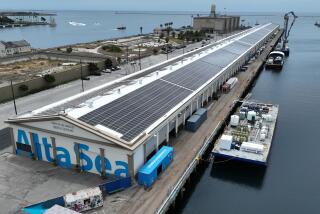Teacher Discovers a Nutritious Gift From the Sea: Veggies
- Share via
SAN FRANCISCO — Alice Green stood in frigid San Francisco Bay at low tide and plucked her dinner from a sea of brown mush.
The nutritious items gathered during the early-morning jaunt were sea vegetables, edible marine algae.
Green, 45, who has taught about the subject for years, said the Northern California coast is the best overall source of these foods in the world.
“The very richest places on the West Coast are Big Sur, Monterey and Point Lobos,” she said. “Japan has more of an abundance than us, and South Africa and New Zealand have more variety. But we have both.”
During the last decade, Green has taught more than 1,000 people the art of cooking and gathering sea vegetables through courses at San Francisco City College and the University of California, Berkeley.
“When people are walking along the beach, people see this steaming mass. The sea vegetables have started their natural decaying process. Sometimes there’s piles of it, and it looks unappetizing,” she said.
But Green said eating sea vegetables is a natural and rational thing to do.
“It’s real exciting for me to gather and eat sea vegetables because I get to connect with the water very directly,” she said. “I can touch something and eat it, and those sea vegetables are very simple forms of life that are affected very little by pollution and processing.
“They’re wild, uncultivated and biologically very simple forms. It takes me back to the very beginnings of life, because they say that all life started in the ocean.
“It’s a wonderful source of food, but people just don’t know about it,” she said, adding that the sea, as an endless source of food, can be used to feed the hungry all over the world.
Sea vegetables are most valued as a source of minerals, she said, adding that they are easily digested because of their gelatinous qualities. They also provide protein, carbohydrates and vitamins and are low in fat and calories.
The three groups of sea vegetables--green, brown and red--look and taste different. The plants can be cooked and dried, eaten raw, boiled, baked or deep fried. The textures range from chewy to crispy. Some taste like sweet grass and others are more like clams and oysters.
The most recognized types of sea vegetables are the greenish-black nori, which is dried and used to wrap sushi, and the greenish-brown bull whip kelp, which has a large bulb on the end.
Others include the emerald green sea lettuce; the clear yellowish alaria; ogo, which looks like stringy brown hair; and iridea, which under water resembles a sheet of black rubber with brilliant hues of purple, greens and blues.
Laura Goldbaum of San Francisco, who took the seminar about two years ago, said she finds gathering sea vegetables “exhilarating.”
“I was looking for a plant source of vitamin B-12. I was living with people who didn’t eat any meat, dairy or eggs, and I was afraid they were suffering from a vitamin deficiency,” Goldbaum said, explaining why she took the class.
“It just opens up a whole new world,” she said. “When you walk on the beach, you think of rotting seaweed. But once you learn about it, you see all these beautiful plants.”
More to Read
Eat your way across L.A.
Get our weekly Tasting Notes newsletter for reviews, news and more.
You may occasionally receive promotional content from the Los Angeles Times.










